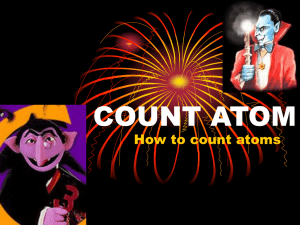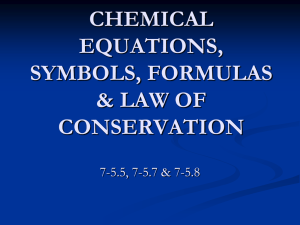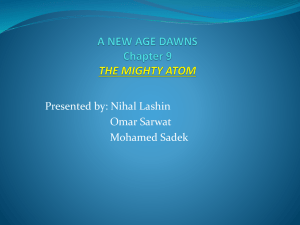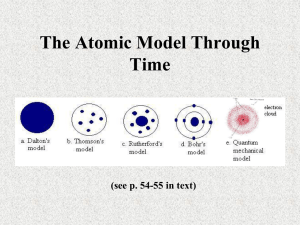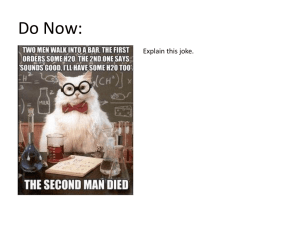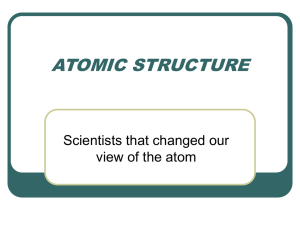Chemical Formulas
advertisement
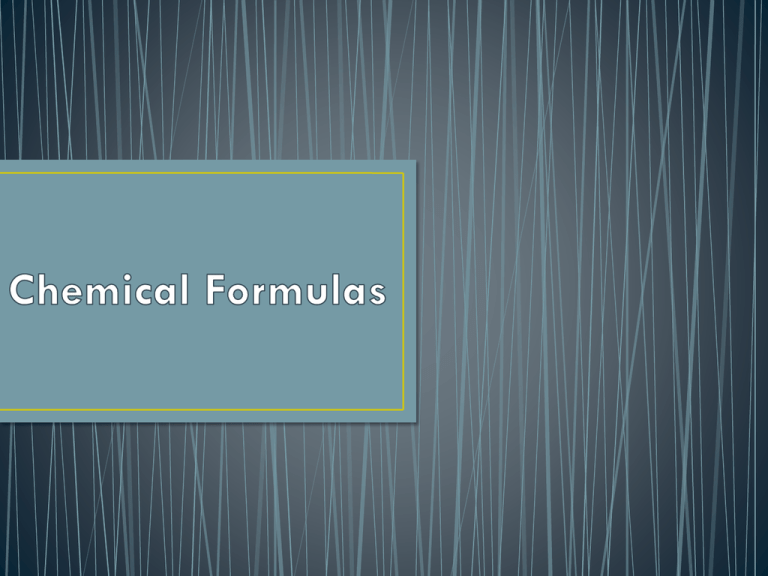
• Recognize that chemical formulas are used to identify substances and determine the number of atoms of each element in chemical formulas containing subscripts. • Recognize whether a chemical equation containing coefficients is balanced or not and how that relates to the law of conservation of mass. • Recognize the importance of formulas and equations in representing chemical reactions– 1998 TEKS 8.9C • Teacher can type answers in here. • Chemical, or molecular, formulas are a concise way of expressing information about the atoms that constitute a particular chemical compound. • Wait…what? • It is an expression which states the number and type of atoms present in a molecule of a substance. MgSO4 • A subscript is used to represent the number of each atom being represented. • They are only used when more than one atom is being represented. If only one atom is represented, there is no subscript. • In the formula for water, what is the subscript? • There is only one atom of Oxygen, so it does not have a subscript. H2O H = Hydrogen O = Oxygen • Usually the subscript just multiplies or shows the number of atoms of a single element. If the subscript exists outside of a set of parenthesis then it will multiply the atoms of all of the elements inside the parenthesis. N(CH3)3 • How many of each atom are there now? • Answer: Nitrogen-1, Carbon-3, Hydrogen-9 N = Nitrogen C = Carbon H = Hydrogen • In this image Hydrogen atoms are white and Nitrogen atom is red. • Write the chemical formula for this molecule. Answer: NH3 This substance is ammonia • In this image the Carbon atom is black and the Oxygen atoms are red. • Write the chemical formula for this molecule. Answer: CO3 This substance is carbonate • In this image blue represents Nitrogen atoms, red represents Oxygen atoms, white represents Hydrogen atoms and black represents Carbon atoms. • Write the chemical formula for this molecule. Answer: C8H10N4O2 This substance is caffeine • In this image the Carbon atom is blue and the Oxygen atom is red. • Write the chemical formula for this molecule. Answer: CO This substance is carbon monoxide • A harder one: In this image Nitrogen atoms are blue, the Platinum atom is grey, Chlorine atoms are green, and Hydrogen atoms are white. • Write the chemical formula for this molecule. Answer: N2PtH6Cl2 • • • • Coefficients appear on the left side of a chemical formula. They are used to multiply all the atoms in a compound In the following formula, which is the coefficient? Earlier we learned that the subscript 2 meant that there were two Hydrogen atoms. The coefficient 7 means there are 7 times more. • How many Hydrogen atoms do we have? • How many Oxygen atoms? 7H2O • representation of chemical reaction in equation: a representation, using chemical symbols in a form resembling a mathematical equation, of the process involved in a chemical reaction 2H2+O22H2O • This is an example of a chemical equation. The components on the left combine together to yield (represented by the arrow) the component on the right. • The quantity of a specified product obtained in a reaction or series of reactions, usually expressed as a percentage of the quantity that is theoretically obtainable • What is produced. • Which side represents the products? 2H2+O22H2O • They are found on the right side of a chemical equation. • The starting substances. • Which side represents the reactants? 2H2+O22H2O • They are found on the left side of a chemical equation. • Atoms are neither created, nor destroyed, during any chemical reaction. • This means that the same number of atoms that are present after a reaction are the same number of atoms that are present before a reaction. • There is only a rearrangement • Write out your “un-balanced” equation using formulas of reactants and products. CH4+O2CO2+H2O • Count up the atoms in the products and reactants. • How many carbons, hydrogens, and oxygens are on each side? Are they equal? CH4+O2CO2+H2O C=1 H=4 O=2 They are NOT equal C=1 H=2 O=3 • Since our carbons are ok we will not mess with those now. • However, we have half the number of hydrogens in the products than we do in the reactants. • What do we need to add? Where do we add it? CH CH44+O +O22CO CO22+H +2H O O 2 2 C=1 H=4 O=2 They are still NOT equal C=1 H=4 O=4 • Now we have half the number of Oxygens. • What do we need to add? Where do we need to add it? Is everything equal now? CH CO +2H O CH44+2O +O2CO +2H O 2 22 22 C=1 H=4 O=4 They ARE now balanced C=1 H=4 O=4 2H H2+O22H H2O O 2 Fe+Cl2FeCl 2Fe+3Cl 2FeCl 3 3 2 Cu+2AgNO33Cu(NO Cu(NO33)2)+2Ag Cu+AgNO +Ag 2 Zn+2HClZnCl Zn+HClZnCl22+H +H22 Pb(NO3)22+2AlCl +AlCl33PbCl PbCl2+2Al(NO +Al(NO3)33 3Pb(NO


